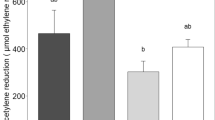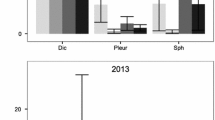Abstract
Pioneer mosses are among the dominant vegetation in the early stages of xeric successions. Recent climate warming may have a significant effect on the productivity of these mosses, thereby affecting successional processes. In this study, we investigated the effects of temperature changes on the productivity of Racomitrium japonicum, a pioneer moss species commonly found on open ground in Japan. We examined the microclimate (moss temperature and water content) of a natural R. japonicum stand in Higashi-Hiroshima City, western Japan, and related them to the climate records of the weather station to create a model for estimating microclimate from past climatic data. We also examined the effects of environmental factors (light, temperature, and water) on photosynthesis in the laboratory to construct a production model. Using these models, we estimated the net primary production (NPP) over the last 10 years (2009–2018) based on the climatic data (air temperature and precipitation) recorded at the weather station of Higashi-Hiroshima City. The estimated NPP showed negative values in summer, which indicated that respiratory carbon loss exceeded photosynthetic carbon gain. In contrast, NPP was positive in the spring and winter seasons throughout the 10 years. Autumn NPP varied widely, showing both positive and negative values. The annual NPP also showed considerable year-to-year variations. Additionally, we examined the effects of temperature conditions on NPP assuming annual temperature changes of 0 °C (present temperature), + 1 °C, and + 2 °C. The results indicated that NPP decreased with increasing temperature, except in the winter season. The findings of this study suggest that climate warming has a large impact on the NPP of R. japonicum; however, the impact can be both positive and negative depending on the season. The results also suggest that future climate warming is likely to decrease NPP on an annual basis.











Similar content being viewed by others
References
Alpert P, Oechel WC (1987) Comparative patterns of net photosynthesis in an assemblage of mosses with contrasting microdistributions. Am J Bot 74:1787–1796
Collins NJ (1977) The growth of mosses in two contrasting communities in the maritime Antarctic: measurement and prediction of net annual production. In: Llano GA (ed) Adaptation within Antarctic ecosystem. Smithsonian Institution, Washington D. C., pp 921–933
Collins NJ, Callaghan TV (1980) Predicted patterns of photosynthetic production in maritime Antarctic mosses. Ann Bot 45:601–620
Davey MC, Rothery P (1997) Interspecific variation in respiratory and photosynthetic parameters in Antarctic bryophytes. New Phytol 137:231–240
Day TA, Ruhland CT, Xiong FS (2008) Warming increases aboveground biomass and C stocks in vascular-plant-dominated Antarctic tundra. Glob Change Biol 14:1827–1843
Deguchi H (1989) Key to the Japanese species of the Racomitrium canescens group. Proc Bryol Soc Jpn 5:21–24 ((in Japanese))
Dilks TJK, Proctor MCF (1975) Comparative experiments on temperature responses of bryophytes: assimilation, respiration and freezing damage. J Bryol 8:317–336
Dilks TJK, Proctor MCF (1979) Photosynthesis, respiration and water content in bryophytes. New Phytol 82:97–114
During HJ, Van Tooren BF (1990) Bryophyte interaction with other plants. Bot J Linn Soc 104:79–98
Fukuta E, Sasaki A, Nakatsubo T (2012) Microclimate and production of peat moss Sphagnum palustre L. in the warm-temperate zone. Plant Spec Biol 27:110–118
Gaberščik A, Martinčič A (1987) Seasonal dynamics of net photosynthesis and productivity of Sphagnum papillosum. Lindbergia 13:105–110
Gerdol R (1996) The seasonal growth pattern of Sphagnum magellanicum Brid. In different microhabitats on a mire in the southern Alps (Italy). Oecologia Montana 5:13–20
He X, He KS, Hyvönen J (2016) Will bryophytes survive in a warming world? Prespect Plant Ecol Evol Syst 19:49–60
Hearnshaw GF, Proctor MCF (1982) The effect of temperature on the survival of dry bryophytes. New Phytol 90:221–228
Hill PW, Farrar J, Roberts P, Farrell M, Grant H, Newsham KK, Hopkins DW, Bardgett RD, Jones DL (2011) Vascular plant success in a warming Antarctic may be due to efficient nitrogen acquisition. Nat Clim Chang 1:50–53
IPCC (2014) Climate Change 2014: Synthesis Report. Contribution of Working Groups I, II and III to the Fifth Assessment Report of the Intergovernmental Panel on Climate Change [Core Writing Team, R.K. Pachauri and L.A. Meyer (eds.)]. IPCC, Geneva
Iwatsuki Z (2001) Mosses and liverworts of Japan. Heibonsha Ltd., Tokyo (in Japanese)
Jägerbrand AK, Kudo G, Alatalo JM, Molau U (2012) Effects of neighboring vascular plants on the abundance of bryophytes in different vegetation types. Polar Sci 6:200–208
Keever C, Oosting HJ, Anderson LE (1951) Plant succession on exposed granite of Rocky Face Mountain, Alexander Country, North Carolina. Bull Torrey Bot Club 78:401–421
Kumarathunge DP, Medlyn BE, Drake JE, Tjoelker MG, Aspinwall MJ, Battaglia M, Cano FJ, Carter KR, Cavaleri MA, Cernusak LA, Chambers JQ, Crous KY, Kauwe MGD, Dillaway DN, Dreyer E, Ellsworth DS, Ghannoum O, Han Q, Hikosaka K, Jensen AM, Kelly JWG, Kruger EL, Mercado LM, Onoda Y, Reich AM, Rogers A, Slot M, Smith NG, Tarvainen L, Tissue DT, Togashi HF, Tribuzy ES, Uddling J, Vårhammar A, Wallin G, Warren JM, Way DA (2019) Acclimation and adaptation components of the temperature dependence of plant photosynthesis at the global scale. New Phytol 222:768–784
Larcher W (2003) Physiological plant ecology: Ecophysiology and stress physiology of functional groups, 4th edn. Springer, New York
Longton RE (1974) Microclimate and biomass in communities of the Bryum association on Ross Island, continental Antarctica. Bryologist 77:109–127
Longton RE (1984) The role of bryophytes in terrestrial ecosystems. J Hattori Bot Lab 55:147–163
Longton RE (1988) The biology of polar bryophytes and lichens. Cambridge University Press, Cambridge
Maruta E (1986) Temperature and energy budget of Rhacomitrium lanuginosum and Grimmia elongata at the top of Mt. Fuji (extended abstract). Mem Natl Inst Polar Res Spec Issue 44:254–256
Michel P, David JB, William GL (2011) Bryophytes display allelopathic interactions with tree species in native forest ecosystems. Oikos 120:1272–1280
Molau U, Alatalo JM (1998) Responses of subarctic-alpine plant communities to simulated environmental change: biodiversity of bryophytes, lichens, and vascular plants. Ambio 27:322–329
Möls T, Vellak K, Vellak A, Ingerpuu N (2013) Global gradients in moss and vascular plant diversity. Biodivers Conserv 22:1537–1551
Nakatsubo T (1994) The effect of growth form on the evaporation in some subalpine mosses. Ecol Res 9:245–250
Nakatsubo T (1997) The role of bryophytes in terrestrial ecosystems with special reference to forests and volcanic deserts. JPN J Ecol 47:43–54 ((in Japanese with English summary))
Nakatsubo T (2002) Predicting the impact of climatic warming on the carbon balance of the moss Sanionia uncinata on a maritime Antarctic island. J Plant Res 115:99–106
Nakatsubo T, Takamine Y, Ino Y (1989) Response patterns of net photosynthesis to moisture of mosses in xeric habitats. Bot Mag Tokyo 102:63–73
Pannewitz S, Green TGA, Maysek K, Schlensog M, Seppelt R, Sancho LG, Türk R, Schroeter B (2005) Photosynthetic responses of three common mosses from continental Antarctica. Antarctic Sci 17:341–352
Proctor MCF (1982) Physiological ecology: water relations, light and temperature responses, carbon balance. In: Smith AJE (ed) Bryophyte ecology. Chapman and Hall, London, pp 333–381
R Core Team (2018) R: a language and environment for statistical computing. R Foundation for Statistical Computing, Vienna, Austria. URL https://www.R-project.org/
Rieley JO, Richards PW, Bebbington ADL (1979) The ecological role of bryophytes in a North Wales woodland. J Ecol 67:497–527
Rundel PW (1975) Primary succession on granite outcrops in the montane Southern Sierra Nevada. Madroño 23:209–220
Rundel PW, Lange OL (1980) Water relations and photosynthetic response of a desert moss. Flora 169:329–335
Russell S, Botha CEJ (1988) Measurement of bryophyte growth 2. Gas exchange techniques. In: Glime JM (ed) Methods in bryology. Nichinan, Proc Bryol Meth Workshop, Mainz, Hattori Bot Lab, pp 259–273
Scarpitta AB, Bardat J, Lalanne A, Vellend M (2017) Long-term community change: bryophytes are more responsive than vascular plants to nitrogen deposition and warming. J Veg Sci 28:1220–1229
Shirasaki H (1995) Ecological distribution of bryophytes 5. Racomitrium barbuloides and R. japonicum of R. canescens group (Musci). J Phytogeogr Taxon 42:157–164 ((in Japanese with English summary))
Sonesson M, Gehrke C, Tjus M (1992) CO2 environment, microclimate and photosynthetic characteristics of the moss Hylocomium splendens in a subarctic habitat. Oecologia 92:23–29
Thornley JHM (1976) Mathematical models in plant physiology. Academic Press, London
Turetsky MR (2003) The role of bryophytes in carbon and nitrogen cycling. Bryologist 106:395–409
Turetsky MR, Bond-Lamberty B, Euskirchen E, Talbot J, Frolking S, McGuire AD, Tuittila E-S (2012) The resilience and functional role of moss in boreal and arctic ecosystems. New Phytol 196:49–67
Uchida M, Muraoka H, Nakatusbo T, Bekku Y, Ueno T, Kanda H, Koizumi H (2002) Net photosynthesis, respiration, and production of the moss Sanionia uncinata on a glacier foreland in the high Arctic, Ny-Ålesund, Svalbard. Arct Antarct Alp Res 32:287–292
Uchida M, Muraoka H, Nakatsubo N (2016) Sensitivity analysis of ecosystem CO2 exchange to climate change in High Arctic tundra using an ecological process-based model. Polar Biol 39:251–265
Ueno T, Bekku Y, Uchida M, Kanda H (2006) Photosynthetic light responses of a widespread moss, Sanionia uncinata, from contrasting water regimes in high Arctic tundra, Svalbard, Norway. J Bryol 28:345–349
Wagner S, Zotz G, Bader MY (2014) The temperature acclimation potential of tropical bryophytes. Plant Biol 16:117–124
Walther GR (2003) Plants in a warmer world. Perspect Plant Ecol Evol Syst 6:169–185
Yamaguchi DP, Nakaji T, Hiura T, Hikosaka K (2016) Effects of seasonal change and experimental warming on the temperature dependence of photosynthesis in the canopy leaves of Quercus serrata. Tree Physiol 36:1283–1295
Yamori W, Hikosaka K, Way DA (2014) Temperature response of photosynthesis in C3, C4, and CAM plants: temperature acclimation and temperature adaptation. Photosynth Res 119:101–117
Acknowledgments
We would like to thank Dr. Masaki Uchida of the National Institute of Polar Research for his helpful advice during the photosynthesis measurements, Dr. Yoko Iwamoto of the Graduate School of Integrated Sciences for Life, Hiroshima University, for providing us with solar radiation data, and Editage (www.editage.com) for English language editing.
Author information
Authors and Affiliations
Corresponding author
Additional information
Publisher's Note
Springer Nature remains neutral with regard to jurisdictional claims in published maps and institutional affiliations.
Membership holder: Takayuki Nakatsubo.
Electronic supplementary material
Below is the link to the electronic supplementary material.
Rights and permissions
About this article
Cite this article
Osaki, S., Nakatsubo, T. Effects of climate warming on the production of the pioneer moss Racomitrium japonicum: seasonal and year-to-year variations. J Plant Res 134, 115–126 (2021). https://doi.org/10.1007/s10265-020-01240-w
Received:
Accepted:
Published:
Issue Date:
DOI: https://doi.org/10.1007/s10265-020-01240-w




